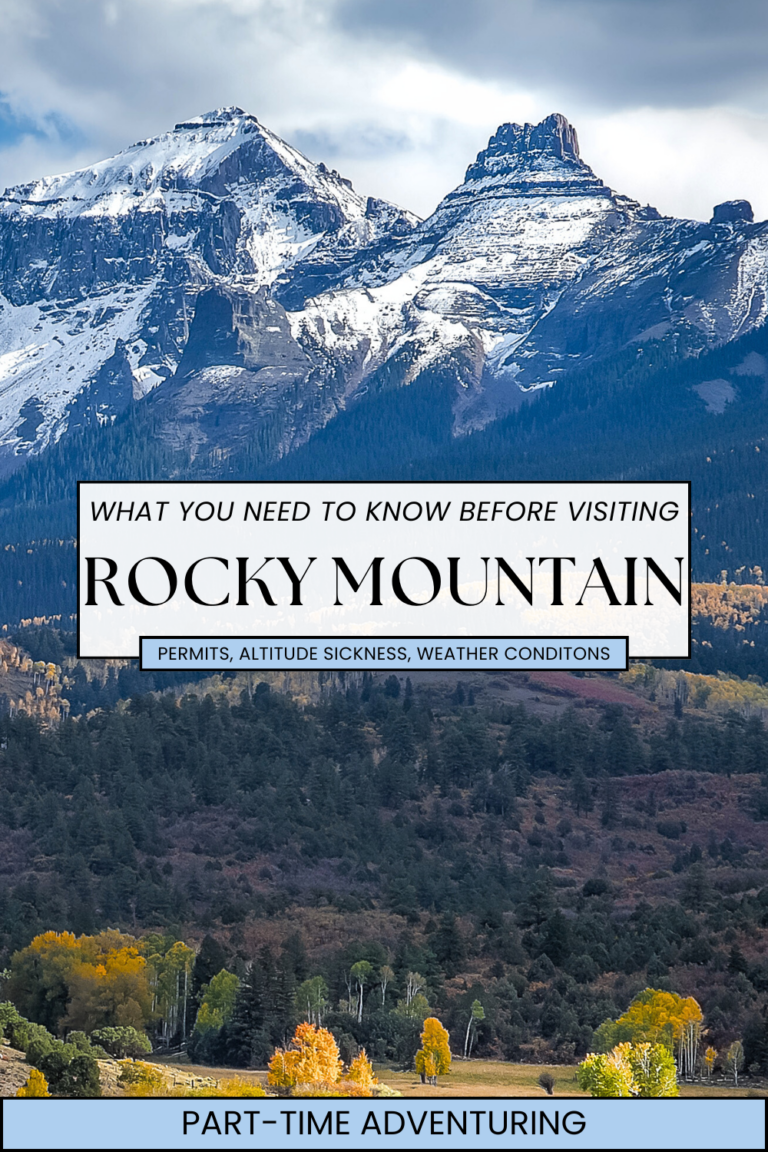Rocky Mountain National Park (RMNP) is one of the most visited and beloved national parks in the U.S., attracting millions of visitors each year. With its stunning mountain views, diverse wildlife, and endless outdoor activities, it’s no surprise that RMNP draws adventurers from all over. However, as with any popular destination, planning your trip requires some foresight—especially now that the park has implemented a Timed Entry Reservation System. Here’s everything you need to know to make the most of your trip to RMNP in 2025.
Entrance Fees at Rocky Mountain National Park
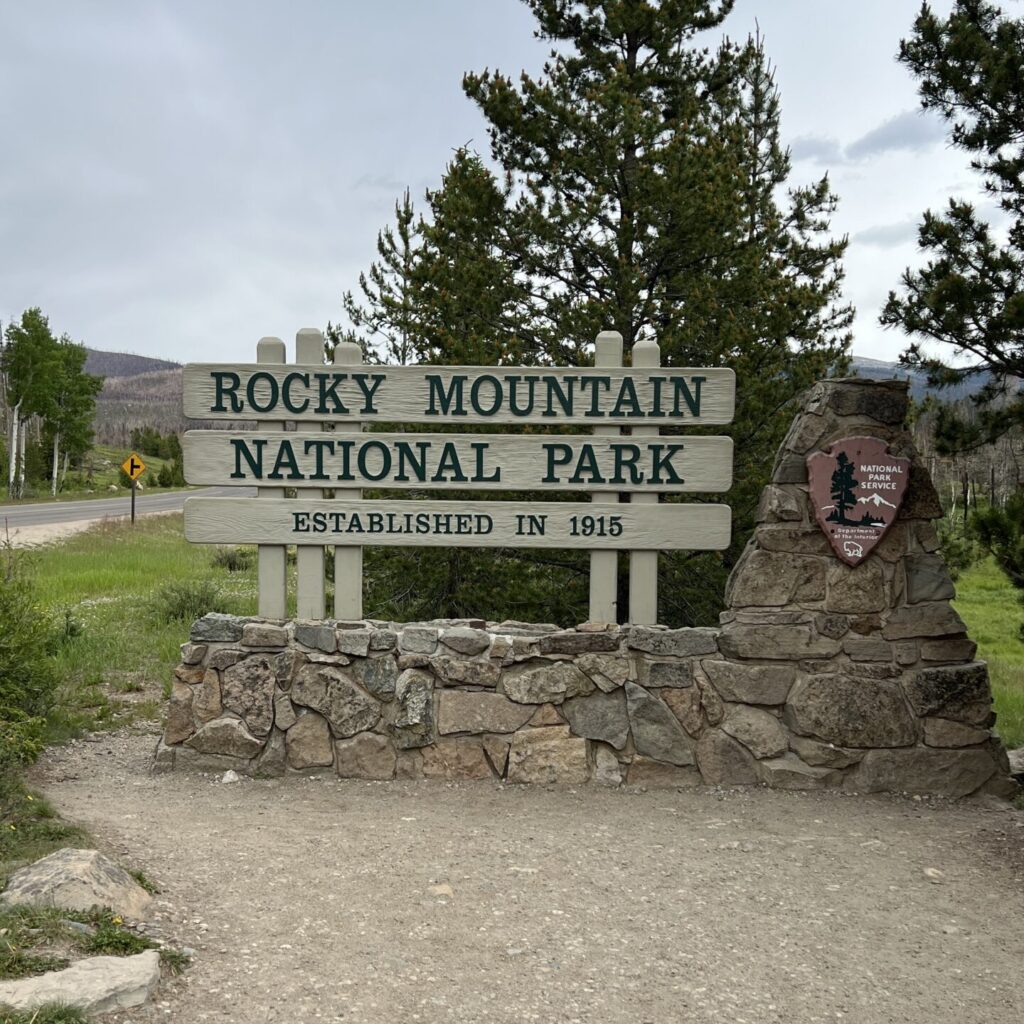
All visitors to Rocky Mountain National Park must have an entrance pass to access the park. Here’s a breakdown of the available passes:
- Standard Pass: $15.00 – $35.00 (varies based on the type of vehicle)
- RMNP Annual Pass: $70.00
- America the Beautiful Pass (includes Senior Passes): Free – $80.00
- This pass gets you into the 63 National Parks + 2,000 other federally managed sights for a year.
Plan to go cashless: RMNP does not accept cash for entrance fees, so make sure to pay with a credit card when you arrive.
Why Rocky Mountain National Park Requires Timed Entry Permits
In 2022, RMNP saw more than 4.3 million visitors, making it one of the most visited national parks in the U.S. While this influx of visitors is a testament to the park’s appeal, it also puts a strain on its resources. To protect the park’s fragile ecosystem and ensure a positive experience for all visitors, RMNP has introduced a Timed Entry Reservation System. This system will be in effect from May 23 to October 20, 2025, during the busiest months.
The goal of the timed entry system is to manage the flow of visitors during peak hours and reduce overcrowding. It’s designed to give visitors a fair chance at experiencing the park without feeling rushed or overwhelmed by excessive traffic. To enter the park during designated peak hours, visitors must secure a timed entry permit in advance.
Understanding the Two Permit Types
There are two types of timed entry permits that allow access to different areas of RMNP. It’s essential to understand which one you need to ensure your visit goes smoothly.
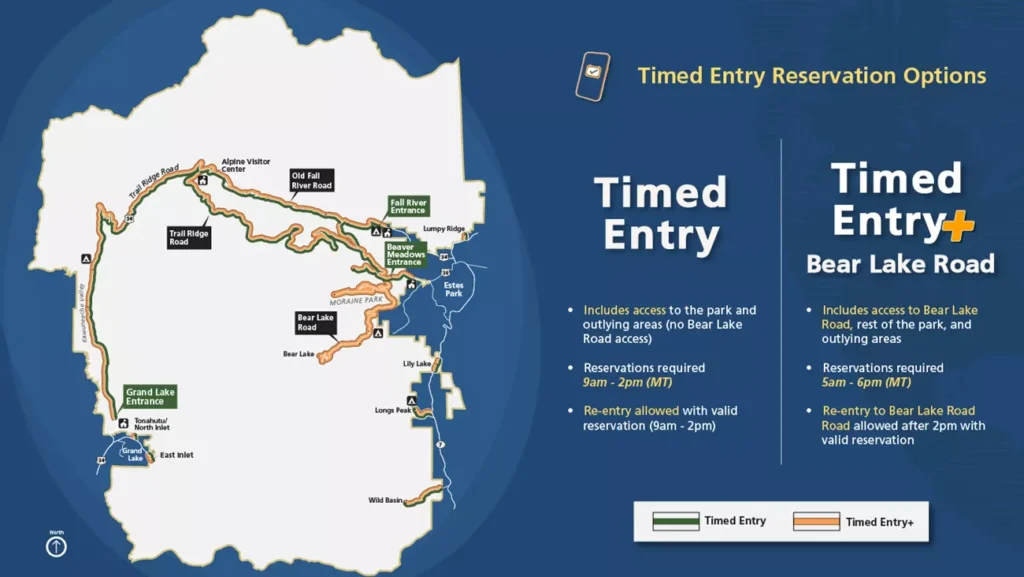
Timed Entry + Bear Lake Road Reservation
- Required for access to the Bear Lake Road Corridor, including popular destinations like Bear Lake, Glacier Gorge, and Alberta Falls.
- Entry window: 5 AM to 6 PM.
- Coverage: This permit grants access to all areas of RMNP, not just the Bear Lake Corridor.
Timed Entry Reservation (Rest of the Park)
- Required for access to the rest of the park outside the Bear Lake Corridor.
- Entry window: 9 AM to 2 PM.
- Restrictions: This permit does not allow access to Bear Lake during restricted hours (5 AM – 6 PM).
It’s crucial to reserve the correct type of permit based on which areas of the park you plan to visit. If you intend to explore Bear Lake or other hotspots in the Bear Lake Corridor, make sure you secure the appropriate timed entry + Bear Lake Road reservation.
When the Permit System is in Effect (2025 Dates)
- May 23 – October 14, 2025: Timed entry permits are required to enter the entire park.
- May 23 – October 20, 2025: Bear Lake Corridor permits are required.
This system will help manage the number of visitors in the park, especially in high-traffic areas like Bear Lake and Alberta Falls, making your experience more enjoyable.
How to Reserve a Timed Entry Permit
Reservations for timed entry permits must be made through Recreation.gov, with a $2 processing fee per reservation. Here’s a breakdown of when reservations open for each period:
- May 1: Reservations open for May 23 to June 30.
- June 1: Reservations open for July (plus remaining June dates).
- July 1: Reservations open for August (plus remaining July dates).
- August 1: Reservations open for September (plus remaining August dates).
- September 1: Reservations open for October (plus remaining September dates).
It’s a good idea to book your permit early, as these reservations can fill up quickly, particularly during peak months like July and August.
What If You Don’t Get a Permit?
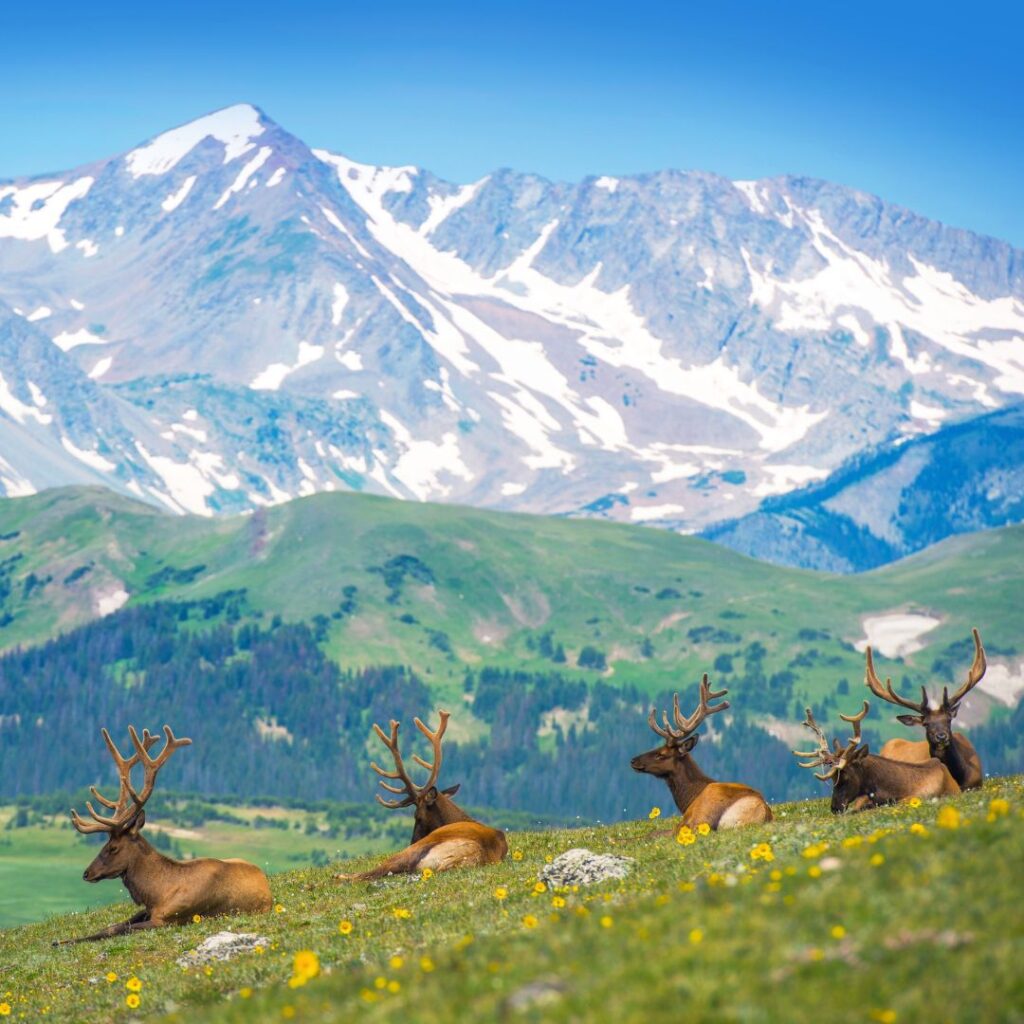
If you miss out on securing a timed entry permit, don’t worry—there are still ways to experience the park:
- Enter during non-permit hours:
- For general entry, visit before 9 AM or after 2 PM.
- For Bear Lake, try getting on the free shuttle.
- Explore less crowded areas: RMNP is vast, and there are many beautiful and less trafficked areas. Consider hiking in Wild Basin or Kawuneeche Valley, both of which offer scenic beauty without the large crowds.
Elevation and Weather at Rocky Mountain National Park
Rocky Mountain National Park is known for its high elevation, with many trails starting above 10,000 feet. Altitude sickness is a common concern for those who aren’t acclimated to higher elevations, so it’s important to prepare properly before setting out on your adventure.
Acclimatize to Higher Elevation
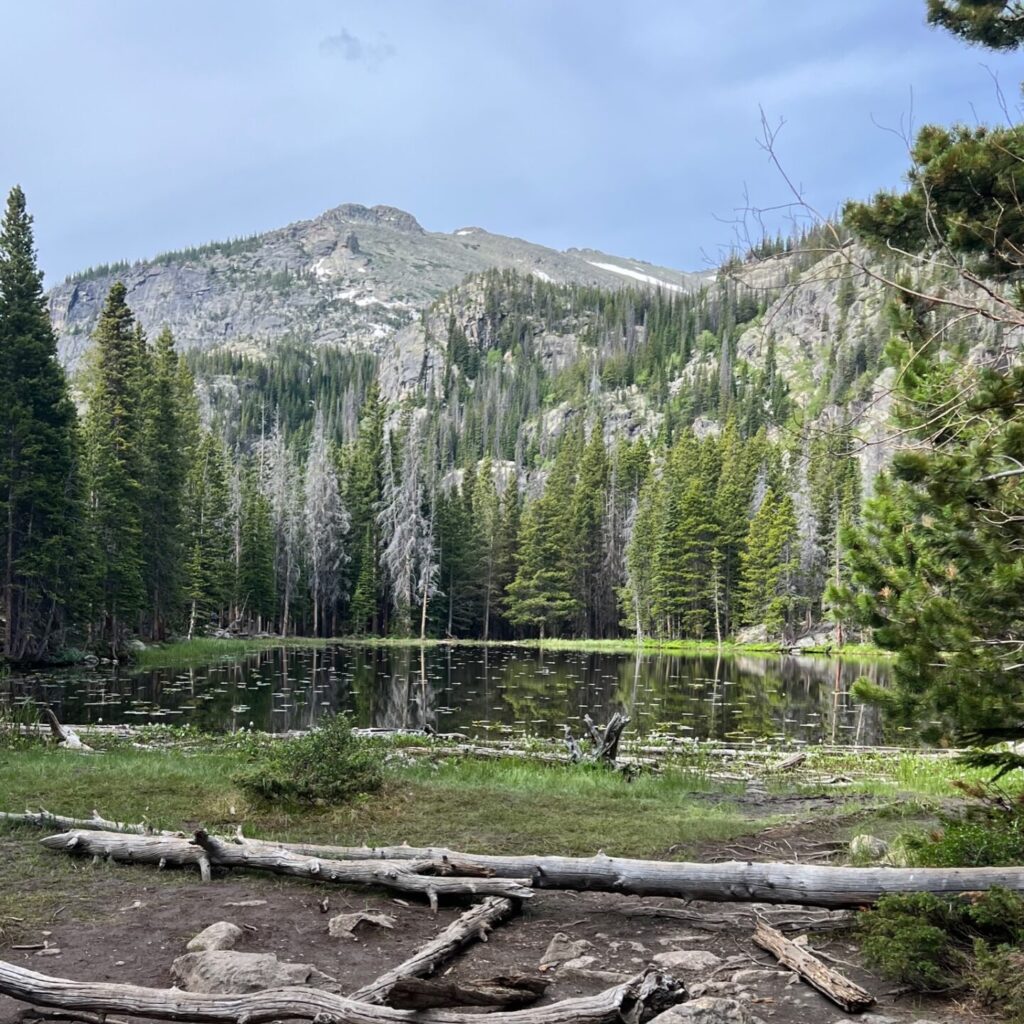
- Take it slow: If you’re not used to being at high altitudes, it’s essential to pace yourself. Don’t push too hard on your first day, especially if you’re tackling a strenuous hike.
- Hydrate: Staying well-hydrated can help your body adjust to the lower oxygen levels.
- Recognize symptoms of altitude sickness: These may include headaches, dizziness, and nausea. If you start to feel unwell, it’s crucial to stop and rest at a lower elevation.
Weather Conditions
The weather in RMNP can be unpredictable, especially at higher elevations. While lower areas might be warm, higher elevations can experience snow even in the summer months. Always check the weather forecast before you go, and pack accordingly:
- Layers: Temperatures can fluctuate, so bring clothes you can easily add or remove.
- Waterproof gear: Storms can develop quickly, especially in the afternoons, so pack a waterproof jacket or poncho.
- Sun protection: The higher you go, the more intense the sun. Bring sunscreen, sunglasses, and a hat to protect yourself.
Using the Shuttle System to Navigate RMNP
One of the best ways to explore Rocky Mountain National Park without the hassle of parking is to take advantage of the free shuttle system. During the summer months (late May to mid-October), the shuttle helps alleviate traffic congestion and provides easy access to some of the park’s most popular areas. Please double check the NPS website for the most accurate information.
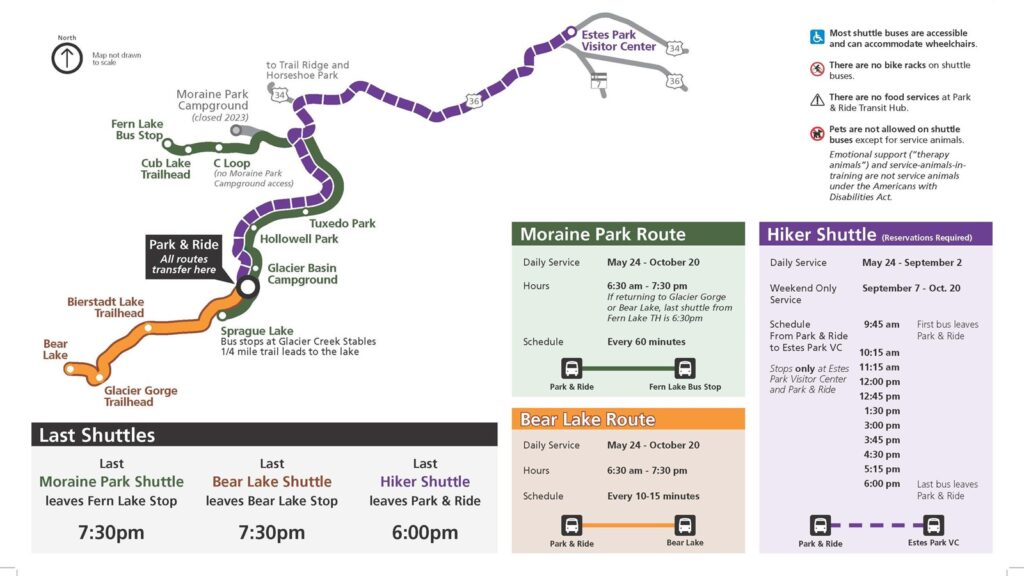
Shuttle Routes and Schedules
- Bear Lake Shuttle: This shuttle stops at key trailheads in the Bear Lake Corridor, including the Park & Ride Transit Hub, Bierstadt Lake Trailhead, Glacier Gorge Trailhead, and Bear Lake Parking Area.
- Moraine Park Shuttle: Connects with the Bear Lake Shuttle at the Park & Ride Transit Hub and provides access to the Moraine Park area.
- Hiker Shuttle: Runs from the Estes Park Visitor Center to the Park & Ride Transit Hub, making it ideal if you’re staying in town. A reservation is needed.
Key Shuttle Details
- Shuttles typically operate from late May through mid-October—always check the official Shuttle Bus webpage for up-to-date schedules.
- Estes Park also offers free shuttles within town for easy access to dining, shopping, and accommodations.
Taking the shuttle not only saves time and reduces stress but also helps protect the park’s natural beauty by cutting down on traffic and pollution.
Additional Tips for Visiting Rocky Mountain National Park
- Arrive early or late: To avoid the largest crowds, try to visit the park either early in the morning or later in the afternoon. The busiest hours tend to be from 8 AM to 3 PM, so aim to arrive before sunrise or after 3 PM to experience the park with fewer people.
- Explore lesser-known areas: If you’re looking to avoid the crowds around Bear Lake, consider hiking in areas like Wild Basin, Kawuneeche Valley, or Moraine Park. These regions offer amazing scenery without the congestion.
- Check Trail Conditions: Some trails may be closed or difficult to access due to weather conditions, so make sure to check current trail status on the official RMNP website.
- Wear proper footwear: Many of RMNP’s trails are rugged, with steep inclines and rocky paths. Make sure to wear sturdy, comfortable hiking boots or shoes that are suitable for the terrain.
Final Thoughts
Visiting Rocky Mountain National Park is an unforgettable experience, but it requires some planning to ensure you make the most of your time there. From securing the correct timed entry permit to navigating the park’s high elevation and unpredictable weather, preparation is key. By taking advantage of the shuttle system and exploring less crowded areas, you’ll be able to enjoy RMNP’s stunning beauty while minimizing your impact on the park.
Whether you’re hiking to high-altitude lakes, spotting wildlife, or simply taking in the breathtaking mountain views, Rocky Mountain National Park has something for everyone. So, plan ahead, secure your permits, and get ready for an adventure you’ll never forget!
Looking for more National Park travel tips?
If you found this guide helpful, check out some of my other posts to help plan your next adventure:
Top National Park Planning Tips
How to Plan the Perfect National Park Road Trip
National Park Packing Checklist
Explore more and make your National Park adventures even better!

